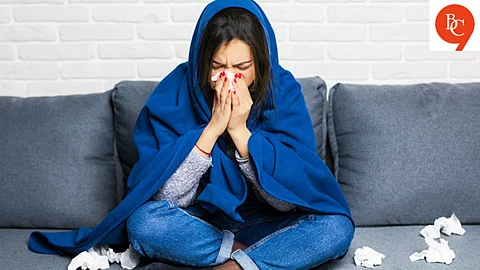

Humidity, stagnant water, and a dip in immunity make it the perfect breeding ground for bacteria, viruses, and fungi. From sniffles to serious diseases, this is the time when your body is most vulnerable.
If you're living in a city like Pune, where the rains are both romantic and relentless, it's important to stay aware, cautious, and protected.
Here are the most common infections to watch out for during the monsoon—plus how you can prevent them.
1. Cold and Flu
Cause: Sudden temperature fluctuations, damp clothes, and viral transmission in close settings.
Symptoms: runny nose, sore throat, cough, mild fever, body aches
Prevention Tips:
Keep yourself dry and warm after getting wet in the rain
Avoid cold drinks or ice-based foods during this season
Drink warm water or herbal teas (with ginger/tulsi)
2. Viral Fever
Cause: Exposure to infected individuals or unsanitary environments. Monsoon lowers immunity, making viral infections spread more easily.
Symptoms: high temperature, chills and sweating, weakness, body pain, headache
Prevention Tips:
Avoid crowded public places when possible
Wash hands frequently with soap
Boost immunity with vitamin C-rich foods (lemon, oranges, amla)
3. Dengue and Malaria
Cause: Mosquito bites, especially from breeding in stagnant water. Both are prevalent during and after heavy rains.
Symptoms (Dengue): sudden high fever, severe headache, muscle and joint pain, skin rash, low platelet count
Symptoms (Malaria): intermittent fever, sweating, vomiting, muscle pain
Prevention Tips:
Use mosquito repellents and nets
Avoid water stagnation in pots, tires, or clogged drains
Wear full-sleeved clothes, especially at dawn and dusk
4. Gastrointestinal Infections (Food Poisoning, Diarrhea, Typhoid)
Cause: Contaminated food and water. Street food, especially during the rains, can be a high-risk zone.
Symptoms: stomach pain, nausea and vomiting, loose motions, fever – in some cases
Prevention Tips:
Drink only filtered or boiled water
Avoid raw salads, chutneys, and street food
Stick to freshly cooked home meals
5. Leptospirosis
Cause: Wading through dirty, stagnant rainwater infected with animal urine—often found on waterlogged streets.
Symptoms: high fever, muscle aches, pale eyes, vomiting, jaundice in severe cases
Prevention Tips:
Avoid walking in flood water (wear rain boots if needed)
Wash feet thoroughly after returning home
Cover cuts and bruises to avoid infection
6. Fungal Infections (Ringworm, Athlete’s Foot)
Cause: Prolonged dampness, sweat, and poor ventilation in shoes or clothing. Common in humid monsoon conditions.
Symptoms: itchy, red, patchy skin, peeling skin between toes, discoloration of nails, scaly rashes in armpits
Prevention Tips:
Keep skin dry—especially feet and underarms
Use antifungal powders or ointments
Avoid sharing towels, socks, or footwear
7. Conjunctivitis (Eye Flu)
Cause: Viral or bacterial infection that spreads through touch or shared items.
Symptoms: redness in eyes, watering, itching or burning, discharge from the eye
Prevention Tips:
Don’t touch or rub your eyes with unclean hands
Avoid sharing towels, eye makeup, or glasses
Wash hands frequently, especially in public spaces
While monsoon is a season of romance, chai, and cozy weather, it's also a time when your health is at greater risk. By being aware of these common infections and taking timely precautions, you can enjoy the rains without falling sick.
